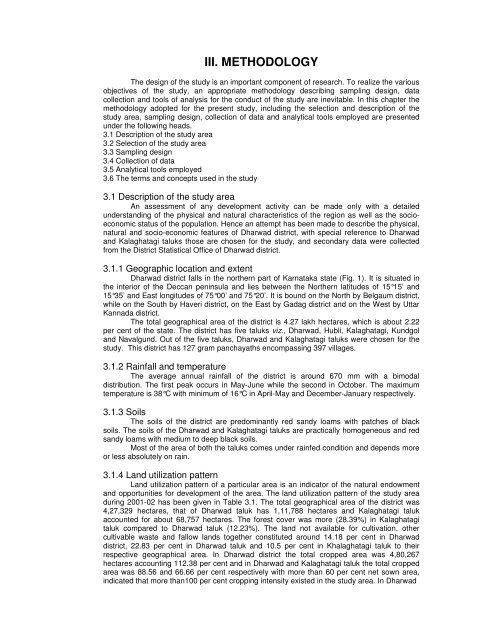Master of Science - ETD | Electronic Theses and Dissertations of ...
Master of Science - ETD | Electronic Theses and Dissertations of ...
Master of Science - ETD | Electronic Theses and Dissertations of ...
Create successful ePaper yourself
Turn your PDF publications into a flip-book with our unique Google optimized e-Paper software.
III. METHODOLOGY<br />
The design <strong>of</strong> the study is an important component <strong>of</strong> research. To realize the various<br />
objectives <strong>of</strong> the study, an appropriate methodology describing sampling design, data<br />
collection <strong>and</strong> tools <strong>of</strong> analysis for the conduct <strong>of</strong> the study are inevitable. In this chapter the<br />
methodology adopted for the present study, including the selection <strong>and</strong> description <strong>of</strong> the<br />
study area, sampling design, collection <strong>of</strong> data <strong>and</strong> analytical tools employed are presented<br />
under the following heads.<br />
3.1 Description <strong>of</strong> the study area<br />
3.2 Selection <strong>of</strong> the study area<br />
3.3 Sampling design<br />
3.4 Collection <strong>of</strong> data<br />
3.5 Analytical tools employed<br />
3.6 The terms <strong>and</strong> concepts used in the study<br />
3.1 Description <strong>of</strong> the study area<br />
An assessment <strong>of</strong> any development activity can be made only with a detailed<br />
underst<strong>and</strong>ing <strong>of</strong> the physical <strong>and</strong> natural characteristics <strong>of</strong> the region as well as the socioeconomic<br />
status <strong>of</strong> the population. Hence an attempt has been made to describe the physical,<br />
natural <strong>and</strong> socio-economic features <strong>of</strong> Dharwad district, with special reference to Dharwad<br />
<strong>and</strong> Kalaghatagi taluks those are chosen for the study, <strong>and</strong> secondary data were collected<br />
from the District Statistical Office <strong>of</strong> Dharwad district.<br />
3.1.1 Geographic location <strong>and</strong> extent<br />
Dharwad district falls in the northern part <strong>of</strong> Karnataka state (Fig. 1). It is situated in<br />
the interior <strong>of</strong> the Deccan peninsula <strong>and</strong> lies between the Northern latitudes <strong>of</strong> 15°15’ <strong>and</strong><br />
15°35’ <strong>and</strong> East longitudes <strong>of</strong> 75°00’ <strong>and</strong> 75°20’. It is bound on the North by Belgaum district,<br />
while on the South by Haveri district, on the East by Gadag district <strong>and</strong> on the West by Uttar<br />
Kannada district.<br />
The total geographical area <strong>of</strong> the district is 4.27 lakh hectares, which is about 2.22<br />
per cent <strong>of</strong> the state. The district has five taluks viz., Dharwad, Hubli, Kalaghatagi, Kundgol<br />
<strong>and</strong> Navalgund. Out <strong>of</strong> the five taluks, Dharwad <strong>and</strong> Kalaghatagi taluks were chosen for the<br />
study. This district has 127 gram panchayaths encompassing 397 villages.<br />
3.1.2 Rainfall <strong>and</strong> temperature<br />
The average annual rainfall <strong>of</strong> the district is around 670 mm with a bimodal<br />
distribution. The first peak occurs in May-June while the second in October. The maximum<br />
temperature is 38°C with minimum <strong>of</strong> 16°C in April-May <strong>and</strong> December-January respectively.<br />
3.1.3 Soils<br />
The soils <strong>of</strong> the district are predominantly red s<strong>and</strong>y loams with patches <strong>of</strong> black<br />
soils. The soils <strong>of</strong> the Dharwad <strong>and</strong> Kalaghatagi taluks are practically homogeneous <strong>and</strong> red<br />
s<strong>and</strong>y loams with medium to deep black soils.<br />
Most <strong>of</strong> the area <strong>of</strong> both the taluks comes under rainfed condition <strong>and</strong> depends more<br />
or less absolutely on rain.<br />
3.1.4 L<strong>and</strong> utilization pattern<br />
L<strong>and</strong> utilization pattern <strong>of</strong> a particular area is an indicator <strong>of</strong> the natural endowment<br />
<strong>and</strong> opportunities for development <strong>of</strong> the area. The l<strong>and</strong> utilization pattern <strong>of</strong> the study area<br />
during 2001-02 has been given in Table 3.1. The total geographical area <strong>of</strong> the district was<br />
4,27,329 hectares, that <strong>of</strong> Dharwad taluk has 1,11,788 hectares <strong>and</strong> Kalaghatagi taluk<br />
accounted for about 68,757 hectares. The forest cover was more (28.39%) in Kalaghatagi<br />
taluk compared to Dharwad taluk (12.23%). The l<strong>and</strong> not available for cultivation, other<br />
cultivable waste <strong>and</strong> fallow l<strong>and</strong>s together constituted around 14.18 per cent in Dharwad<br />
district, 22.83 per cent in Dharwad taluk <strong>and</strong> 10.5 per cent in Khalaghatagi taluk to their<br />
respective geographical area. In Dharwad district the total cropped area was 4,80,267<br />
hectares accounting 112.38 per cent <strong>and</strong> in Dharwad <strong>and</strong> Kalaghatagi taluk the total cropped<br />
area was 88.56 <strong>and</strong> 66.66 per cent respectively with more than 60 per cent net sown area,<br />
indicated that more than100 per cent cropping intensity existed in the study area. In Dharwad
















